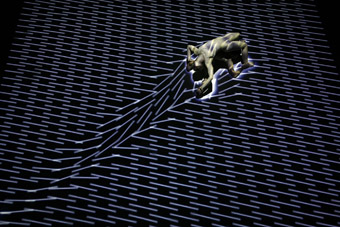Assignment 01-02:
The Rain Room by the Creator’s Project
Unless stated otherwise, all quotations are taken directly from the video on the Creator’s Project official Rain Room video (embedded below) which appears on both the Creator’s Project official YouTube channel and website.
“Rain Room is a 100 square meter area of falling water that uses 3D tracking cameras to sens a person’s presence, allowing visitors to walk through the rain without getting wet.”
If I had to mention one particular computational art project in the world which left a lasting imprint on me, I would have to name the Creator’s Project, the “Rain Room”. It always bothered me how, when the rain started pouring down, people start running around or fumbling for umbrellas and walk around with their heads down and miss the spectacle. I find some people take it for granted that the fact that water falls from the sky in little droplets isn’t weird, unusual, and beautiful. The Rain Room resonated with me because it means that (a) people who are unused to seeing such a natural phenomenon may now do so at their leisure, and (b) people like me who enjoy looking at the rain may do so without getting wet and catching the resulting cold.
“Quite cocooned and protected”
Another aspect I appreciate about the Rain Room is that I don’t feel that one has to be an artist to comprehend or enjoy the experience. For the Museum of Modern Art to offer such a comprehensive installation puts it in good stead with the general public, and I know from talking to many of my non-friends that this is worth the while within and of itself.
“We didn’t intend to trigger memories”
This particular installation was set up by a team of seven artists who collaborate under the title of rAndom International. Three people: Stuart Wood, Florian Ortkrass and Hannes Koch are Founders/Directors. They also function as art directors. The rest of their crew consists of a studio manager, a creative technologist and two designers.
“There was quite a sound element”
The project does boast a considerable lifespan. So far it has been on tour. Interviews picture the creators talking about the adaptable nature of the rain room, particularly in terms of use of space. From a curved wall in one exhibition space to the specially-built housing at the MoMA, these artists have been able to watch their art evolve. They also allowed visitors to take pictured and to upload them — preferably with the hashtag #RainRoom — and would show those images on the MoMA website. These images continue to show the beauty of the rainroom even though the project itself is no longer in existence as of July ’13. The group has now moved on to other projects.
The principal objective of MoMA’s partnership with MoMA PS1 is to promote the enjoyment, appreciation, study, and understanding of contemporary art to a wide and growing audience.
— http://www.moma.org/about/ps1



